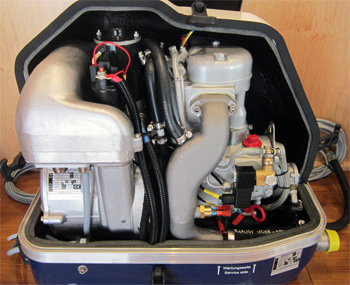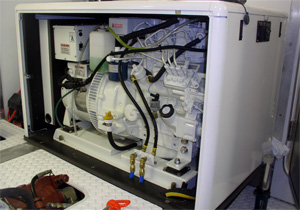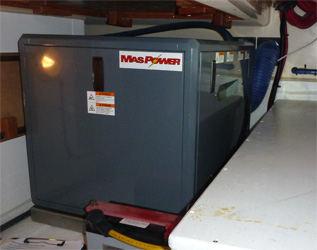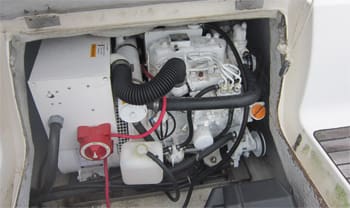As voyaging sailboats grow in size and complexity, having a reliable power supply becomes more important. Although much can be done with DC power alone, it is often necessary to have a good AC power supply as well. When plugged into shore power this is not a problem, but as soon as we venture out away from civilization, AC power becomes a bit more complicated.
Limited AC power can be produced from batteries with the use of an inverter to convert DC to AC. This, however, is usually not capable of providing large loads for extended periods. With increased and ever-growing power demands, an adequate AC generator is often needed to supply all of today’s needs.
The most common type of AC generator is one powered by a small diesel engine. These generators can provide clean stable power for all the AC systems on board while reducing main engine run time for battery charging.
 |
|
Wayne Canning A Fischer Panda 4200 Eco with an integral sound enclosure. |
With increased power demands, generator manufacturers are finding ways to get more power in smaller and lighter packages. All diesel powered generators consist of two basic components. The engine or power source and the generator unit itself, sometimes called the back end or alternator. Both parts of the system have benefited from recent technological improvements. Before we can fully understand these improvements it helps to understand the basics of generator design and construction.
Most generators have the generator unit attached directly to the back end of the drive engine. This is a simple reliable set up, but may not always be the perfect solution. Because the speed the generator must turn is fixed by the number of windings it has, direct drive has advantages and disadvantages. In order to create the 60 cycles required for U.S. power supplies (50 cycles in most other counties) the engine must maintain a steady rpm. If the generator end is a two pole type, then engine speed will need to be 3,600 rpm, if it is a four pole type the engine speed is set at 1,800 rpm.
At first this would seem fairly straight forward, but there are some distinct advantages and disadvantages to one speed over the other. Lower speed motors will be quieter, use less fuel, and have less vibration. The drawback is that with lower rpm the engine is running below peak output. This results in requiring a larger heavier engine for a given amount of AC power produced. Slower engines will also have a harder time handling surge or startup loads.
Peak power ratings
Faster engines can be smaller and thus lighter as they operate at peak power ratings, but because of the higher speed will produce more noise, heat and vibration. Faster running motors can handle start-up loads better as well due to higher inertia and the fact they are operating at near full horsepower. It is generally thought slower running motors last longer as there is less stress and wear on the components. Others however feel it is best to run diesels at rated speeds and power to prevent cylinder glazing and carbon build up. The jury may still be out on this point, but it is clear a slower running motor will be quieter, produce less vibration, and use less fuel.
Larger vessels are not as affected by weight and tend to have more room to accommodate a heavier, larger generator package. With these vessels it makes sense to take advantage of the slower running units with their larger motors. It is on smaller vessels (less than 60 feet) that the size and weight become more important. Some manufacturers such as Next Generation Power and Phasor use a belt drive to reach a compromise in their smaller units. By utilizing different pulley sizes these units can run at 2,800 rpm. This gives the best power rating while keeping weight, size, and vibration to a minimum. The drawback is you have greater maintenance with belt drives. These units, however, use high quality drive belts designed for high loads which improves belt life and reliability.
Most generator manufacturers use small tractor or industrial motors to couple with their own generator units. This keeps costs down and helps when it comes to getting repair parts in far-off locations. For small units in the 3 to 4-kW range, the Farymann single cylinder diesel is popular as it is compact and reliable. Kubota is also a popular engine for the small units, particularly the belt-drive generators. As units get a bit larger manufacturers will often choose a small Kubota or Yanmar tractor motor. Although there may not be a lot new with the motor side of generators, one improvement is the change from belt drive to direct drive of the raw water pump on many new units. This simplifies maintenance and makes for a more reliable water supply. Additional engine improvements come in meeting the new EPA Tier III emission standards.
The generator end
It is the generator end and control systems that really separate one brand from another. These are the parts most manufacturers produce in-house and where the greatest innovation will be found. New trends include digital controls, efficiency improvements in the generator units themselves, voltage stabilization to control voltage spikes and dips and surge controls to help handle high start-up loads typically found in air conditioners and other motors. Other notable improvements can be seen in weight reduction, smaller footprints and greater sound control.
 |
|
Courtesy Northern Lights |
|
A heavy-duty installation is this 12-kW Northern Lights M843NW2 unit, also with a sound enclosure, installed on an Arcturos 50 power voyager. |
The greatest innovations in generator technology have come from the smaller, lighter generators. The desire to reduce weight and size has driven manufacturers such as Fischer Panda and Whisper Power to come up with some interesting improvements. Electrical efficiency drops when temperatures increase and for this reason several manufacturers are opting for water cooling the generator windings. Mase Generators feels this is so important they water cooled their back ends even when using air cooled motors. Other improvements are made by denser packing of the generator windings and using brushless rotors with permanent magnets.
With today’s modern electronics it is critical to maintain steady voltage and frequency in the power supply. This is not a problem when the generator is running with a steady load. It can, however, become an issue when heavy loads such as air conditioning and other devices using electric motors, switch on and off. The momentary start loads can cause frequencies and voltages to drop, sometimes dramatically. Likewise, when a heavy load is shut off the power can briefly surge. These transient spikes and dips can shorten the life of electric motors and possibly damage sensitive electronics. The ability of a generator to respond to these changes is called transient response and becomes of particular importance on small generators.
Frequency is a result of generator rpm and will remain constant under a steady load. The speed the engine is turning is set by a governor on the engine. The problem arises when additional loads are added or removed from the generator. The time it takes the governor to respond to these changes can affect the depth of frequency changes. Typically this should be no more than 3 to 5 percent. With older style mechanical governors the response to loads can be relatively slow. This slow response can cause the engine to momentarily slow down under load and then momentarily over rev as it recovers from the load causing voltage drops and spikes. To combat this problem, electronic governors are sometimes used to react quicker to load changes. The catch is if the response is too fast it could result in the engine stalling. Electronic governors can help keep this critical balance while reducing the depth of the dips and spikes.
Voltage regulation
Voltage regulation is also an important factor in controlling transient response. Most voltage regulation is closely tied to frequency so that as frequency changes, voltage will change as well. Newer electronic voltage controls can help keep the balance between load and power, helping reduce the effect of changes. This may sometimes result in a slower response and recovery time, but will also help level out the depths of change. Some of these newer voltage regulators can boost the voltage during equipment startups to help smooth out the dips.
Fischer Panda has added a proprietary voltage booster circuitry to their line of small generators to help prevent start up loads from over loading the generator. They claim with this new circuitry their smallest unit can start and run two air conditioning units totaling 28,000 BTU, pretty impressive for a 4.2-kW generator.
 |
|
Wayne Canning |
|
A Mas Power 8-kW with sound enclosure installed on an Island Packet 41 SP. |
One of the more noticeable changes in new generators is the introduction of digital remote controls. The days of the simple start/stop panels are numbered as most manufacturers switch to using digital panels. Ease of installation and the ability to get error codes in the event of a fault are the primary advantages. Knowing the errors at a glance can be very helpful in trouble shooting any faults and preventing bigger problems.
Several manufacturers are making panels that will interface with NMEA 2000 networks, allowing the controls to be integrated with other onboard systems.
Noise and vibration
Reducing noise and vibration are also on the forefront of manufacturers improvements. The use of water-cooled windings has helped lessen noise by reducing the size of openings required for the greater volume of air needed with air-cooled windings. Manufacturers of air-cooled units have learned to reduce noise with the use of baffles and ducting designed to block sound waves. Sound enclosures have improved with denser insulation and better construction.
Another major source of noise is from vibration transmitted to the vessel. This is particularly true with newer lighter vessels such as catamarans. New softer mounts are helping reduce this by absorbing vibrations. Improvements have also been made in how exhaust gases are handled. In an effort to reduce exhaust back pressure and improve overall efficiency most manufacturers recommend the use of gas/water separators in the exhaust system. This has the added effect of reducing exhaust noise.
The future holds some interesting new products for power generation. Some companies are working on DC hybrid systems, which will produce DC power for a battery bank that in turn will use inverters to supply AC power. Like hybrid cars, these units will automatically start and come online when there is a larger power demand and shut off when the power use is low. This type of system has several advantages over the conventional AC generators. Because the power is “on demand,” the units will not always be running, this will save fuel and wear on the motor. As DC does not need a set frequency the engine can run at any speed. This allows the generator to run at a lower rpm when demand is low and only increase rpm as demand increases. DC systems will integrate well with solar panels and wind generators as well, further reducing operating costs. DC generators can be used with electric propulsion, allowing the vessel to have a single electric generator to supply all the vessel needs. It may be a few years before we start to see systems like this in widespread use, but as technology improves and costs decrease these systems offer an interesting alternative.
Marine generators are slowly evolving as new technologies come online. Water-cooled windings, innovative load-handling circuits, reduced size and weight and better sound-proofing have all helped in making today’s generators a practical option for most modern vessels with greater power demands.
——————-
Capt. Wayne Canning lives on his Irwin 40 Vayu, in Wilmington N.C. He is a full-time Marine Surveyor, freelance writer, and consultant/project manager on major repairs. Visit www.4ABetterBoat.com and www.projectboatzen.com for more info.

